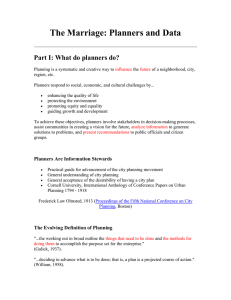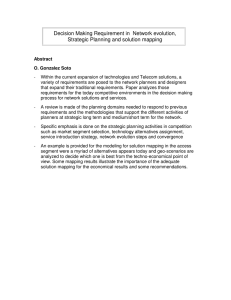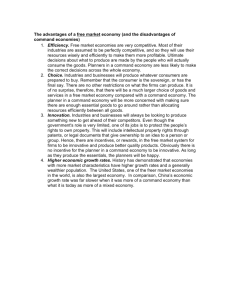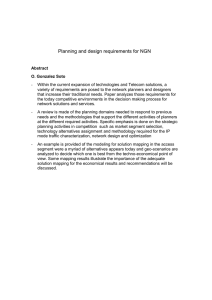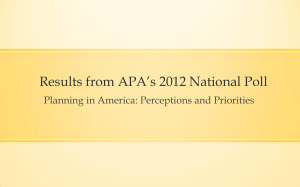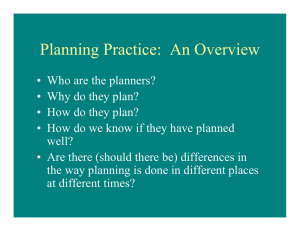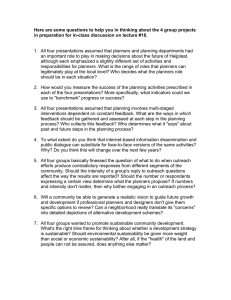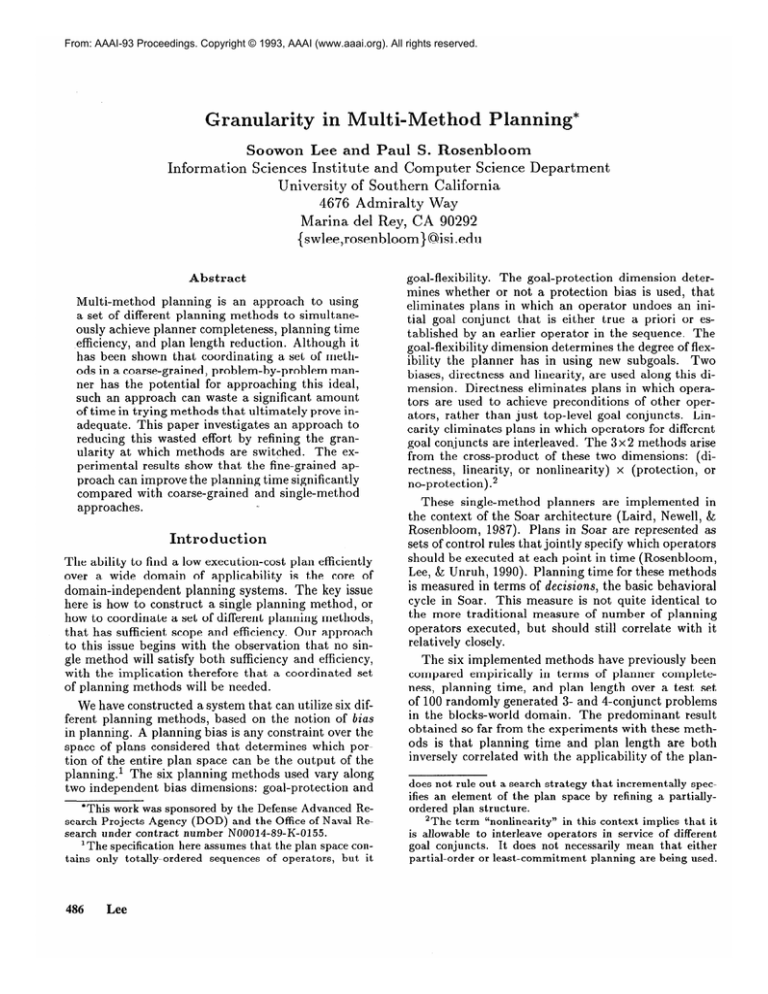
From: AAAI-93 Proceedings. Copyright © 1993, AAAI (www.aaai.org). All rights reserved.
Granularity in Multi-Method
Soowon Lee and Paul S. Rosenbloom
Information Sciences Institute and Computer Science Department
University of Southern California
4676 Admiralty Way
Marina de1 Rey, CA 90292
{ swlee,rosenbloom} @isi.edu
Abstract
Multi-method
planning
is an approach to using
a set of different planning
methods to simultaneously achieve planner completeness,
planning time
efficiency, and plan length reduction.
Although it
has been shown that coordinating
a set of methods in a coarse-grained,
problem-by-problem
manner has the potential
for approaching
this ideal,
such an approach can waste a significant
amount
of time in trying methods that ultimately
prove inadequate.
This paper investigates
an approach to
reducing this wasted effort by refining the granularity at which methods are switched.
The experimental
results show that the fine-grained
approach can improve the planning time significantly
compared with coarse-grained
and single-method
approaches.
Introduction
The ability to find a low execution-cost
plan efficiently
over a wide domain of applicability
is the core of
domain-independent
planning systems.
The key issue
here is how to construct
a single planning method, or
how to coordinate
a set of different planning methods,
that has sufficient scope and efficiency. Our approach
to this issue begins with the observation
that no single method will satisfy both sufficiency and efficiency,
with the implication
therefore that a coordinated
set
of planning methods will be needed.
We have constructed
a system that can utilize six different planning
methods, based on the notion of bias
in planning.
A planning bias is any constraint
over the
space of plans considered
that determines
which portion of the entire plan space can be the output of the
planning.’
The six planning
methods used vary along
two independent
bias dimensions:
goal-protection
and
*This work was sponsored by the Defense Advanced Research Projects Agency (DOD) and the Office of Naval Research under contract number N00014-89-K-0155.
1The specification here assumes that the plan space contains only totally-ordered sequences of operators, but it
486
Lee
goal-flexibility.
The goal-protection
dimension
determines whether or not a protection
bias is used, that
eliminates
plans in which an operator undoes an initial goal conjunct
that is either true a priori or established by an earlier operator in the sequence.
The
goal-flexibility
dimension determines the degree of flexibility the planner has in using new subgoals.
Two
biases, directness and linearity, are used along this dimension.
Directness eliminates
plans in which operators are used to achieve preconditions
of other operators, rather than just top-level goal conjuncts.
Linearity eliminates plans in which operators for different
goal conjuncts are interleaved.
The 3x2 methods arise
from the cross-product
of these two dimensions:
(directness, linearity, or nonlinearity)
x (protection,
or
no-protection).2
These single-method
planners
are implemented
in
the context of the Soar architecture
(Laird, Newell, &
Rosenbloom,
1987). Plans in Soar are represented
as
sets of control rules that jointly specify which operators
should be executed at each point in time (Rosenbloom,
Lee, & Unruh, 1990). Planning time for these methods
is measured in terms of decisions, the basic behavioral
cycle in Soar. This measure is not quite identical to
the more traditional
measure of number of planning
operators
executed,
but should still correlate with it
relatively closely.
The six implemented
methods have previously been
compared
empirically
in terms of planner
completeness, planning
time, and plan length over a test set
of 100 randomly generated 3- and 4-conjunct
problems
in the blocks-world
domain.
The predominant
result
obtained so far from the experiments
with these methods is that planning
time and plan length are both
inversely correlated with the applicability
of the plandoes not rule out a search strategy that incrementally specifies an element of the plan space by refining a partiallyordered plan structure.
2The term “nonlinearity” in this context implies that it
is allowable to interleave operators in service of different
goal conjuncts. It does not necessarily mean that either
partial-order or least-commitment planning are being used.
ning method; that is, the more restricted the method,
the less time it takes to solve the problems that it can
solve, and the shorter are the plans generated.
The
most restricted
method (the method with directness
and protection)
could solve 68 of them, in an average of 16.3 decisions each, producing
plans containing an average of 1.8 operators
(Lee & Rosenbloom,
1992). The least restricted method (nonlinear planning
without goal protection)
could solve all 100 problems;
however, planning time and plan length averaged over
the same 68 problems solvable by the most restricted
method were considerably
worse - an average of 39.0
decisions to produce plans containing
on average 3.3
operators.
This trade-off between completeness
and efficiency
implies that the planning system would be best served
if it could always opt for the most restricted
method
adequate
for its current
situation.
In a first step
towards this ideal, we have begun exploring
multimethod planners that start by trying highly restricted
methods,
and then successively
relax the restrictions
until a method is found that is sufficient for the problem. The intuition
behind this is based on iterative
deepening
(Korf, 1985) - if the proportion
of problems solvable at a particular
level of restriction
is large
enough, and the ratio of costs for successive levels is
large enough, there should be a net gain. Over the set
of 100 blocks-world problems, this has yielded broadly
applicable
multi-method
planners (actually,
complete
for the blocks-world)
that on average generat#e shorter
plans than are produced by corresponding
(complete)
single-method
planners,
with marginally
lower planning times (from 39.9 to 52.5 decisions for singlemethod planners versus from 33.4 to 42.2 decisions for
multi-method
planners).
However these results do not necessarily mean that,
for all situations,
there exists a multi-method
planner which outperforms
the most efficient single-method
planner. In fact, the performance
of these planners depends on the biases used in the multi-method
planners
and the problem set used in the experiments.
For example, if the problems are so complex that most of
the problems are solvable only by the least restricted
method, the performance
loss by trying inappropriate
earlier methods in multi-method
planners might be relatively considerable.
On the other hand, if the problems are so trivial that it takes only a few decisions for
the least restricted method to solve the problems, the
slight performance
gain by using more restricted methods in multi-method
planners might be overridden
by
the complexity of the meta-level processing required to
coordinate
the sequence of primitive planners.
These results suggest that multi-method
planning is
a promising approach, but that further work is necessary to establish whether robust gains are possible over
a wide range of domains.
The work reported here is
one step in this direction,
in which we investigate
reducing the wasted effort in multi-method
planners by
refining the granularity
at which the individual
planning methods can be switched. This approach has been
implemented,
and initial experiments
in two domains
show significant
gains in planning
time with respect
to both single-method
and the earlier, coarser-grained,
multi-method
planners.
Fine-grained
ulti-method
The approach to multi-method
planning described so
far starts with a restricted
method and switches to a
less restricted
method whenever the current method
fails. This switch is always made on a problem-byproblem basis. However, this is not the only granularity at which methods could be switched.
The family
of multi-method
planning systems can be viewed on a
granularity
spectrum.
While in coarse-grained
multimethod planners,
methods are switched for a whole
problem when no solution can be found for the problem within the current method, in fine-grained
multimethod planners,
methods
can be switched
at any
point during a problem at which a new set of subgoals
is formulated,
and the switch only occurs for that set
of subgoals (and not for the entire problem).
At this
finer level of granularity
it is conceivable that the planner could use a highly-restricted
and efficient method
over much of a problem, but fall back on a nonlinear
method without protection for those critical subregions
where there are tricky interactions.
With this flexibility
of method
switching,
finegrained multi-method
planning
can potentially
outperform both coarse-grained
multi-method
planning
and single-method
planning.
Compared
with coarsegrained multi-method
planning,
it can save the effort
of backtracking
when the current method can not find
a solution or the current partial plan violates the biases used in the current method.
Moreover, it can
save the extra effort of using a less restricted method
on later parts of the problem, just because one early
part requires it. As compared with single-method
planning, a fine-grained
multi-method
planner can utilize
biases which would cause incompleteness
in a singlemethod planner - such as directness or protection
in
the blocks-world domain - while still remaining complete. The result is that a fine-grained
multi-method
planner can potentially
be more efficient than a singlemethod planner that has the same coverage of solvable
problems.
One way to construct an efficient multi-method
planner is to order the single method planners
according to increasing
coverage and decreasing
efficiency,
an approach called monotonic multi-method planning.
In this paper, we focus on a special type of monotonic multi-method
planner,
called a strongly monotonic multi-method planner, which is based on the de-
Plan Generation
487
II
Planner
Decisions
A
18.90
-
A& (directness)
MS (linearity)
13.21
14.48
14.81
26.91
24.47
24.84
s3
16.23
40.85
40.96
Table 1: The performance
planners.
of the six single-method
planners
liberate selection and relaxation
of effective biases. In
the next section, we provide a formal definition
of a
monotonic
multi-method
planner,
and define a criterion for selecting effective biases from experiments
with
single-method
planners.
Effective
Biases
Let Mki(hi E (1, . . . . 6)) be a single-method
planner,
as defined in Section 1. A fine-grained
multi-method
planner that consists of a sequence of n different singlemethod planners is denoted as Mkl-kZ+...+k,,
, and the
corresponding
coarse-grained
multi-method
planner is
denoted as Mkl+Mka--)...--fMkR.
Let A be a sample set of problems, and let Aki C A be the subset of
A which are solvable in principle
by Mki. The functions s( MI,; , A,) and I( Mki, A,) represent respectively
the average cost that Mk; requires to succeed and the
average length of plans generated by Mki, for the problems in A, C Aki. Let i%fk,, be a null planner which
cannot solve any problems; that is, Ako = 4.
A multi-method
planner which consists of &!k, , Mk,,
if the following three
“‘f Mk,,, is called monotonic
conditions
hold for each pair of Mk,-l and Mk,, for
2 5 i 5 n: (1) Aki-1 & As, 9 (2) s(Mk,-,
y Ak,-,>
5
+fk,,
Ak+),
for
j
h
i,
and
(3)
l(Mk,.el,
Ak,-1)
5
3 The straightforward
way
to build monotonic
multi-method
planners
is to run
each of the individual
methods on a set of training
problems, and then from the resulting data to generate all method sequences for which monotonicity
holds.
The approach we have taken here is to generate only
a subset of this full set; in particular,
we have focused
only on multi-method
planners in which later methods
embody subsets of the biases incorporated
into earlier
methods,
and in which the biases themselves
are all
‘(Mki,
Akjwl),
for
j
5
i.
positive.
Let Bk,; be the set of biases used in Mk;. A bias
b is called positive in a problem set A and a method
3This is a slight redefinition of monotonicity
& Rosenbloom, 1992) with a minor correction.
488
Lee
A5
12.50
13.00
MI (directness, protection)
MS (linearity, protection)
Ma (protection)
Selecting
A2
from (Lee
for the three problem
set {Mk,},
such
that
sets defined
by the scopes of the
if for each pair of Mk, and MkY in {Mk,}
Bk,
=
Bk,
i-
{b},
s(Mk=,
Ak,)
L
s(Mky,
Ak,)
and /(Mk=, Akj) 5 /(Mk,, AkJ), for every j 5 2. A
multi-method
planner which consists of Mkl, Mk,, . ..,
Mk,, is called strongly monotonic if Bk,-i > Bk,, for
2 5 i 5 n, and Bk,-l - Bk, consists of positive biases
if a multionly, for 2 5 i < 72. From this definition,
method planner% strongly monotonic,
it is monotonic,
while the reverse is not necessarily true.
To generate
a strongly
monotonic
multi-method
planner, it is necessary to determine
which biases are
Table 1 illustrates
the averpositive in the domain.
age number of decisions, s(Mk, , AkJ), and average plan
lengths, /(Mk*, Ak,> for the six single-method
planners
and the problem sets defined by the scope of these planners over a training set of 30 randomly
generated
3and 4-conjunct
problems in the blocks-world
domain.
In this domain, Ad is the same as A1 because if a problem is not solvable with protection,
it also is not solvAg is the same as A6 because
able with directness.
both it15 and Ms are complete in this domain, though
MS may not be able to generate an optimal solution.
A2 and A3 are different sets in principle, because problems such as Sussman’s anomaly cannot be solved by
a linear planner with protection
(M2) but can be by
a nonlinear
planner with protection
(MS). However,
among the 30 problems, these “anomaly” problems did
not occur, yielding A2 = A3 for this set of problems.
The results imply that directness
and protection
are
while linearity
is not, since
positive in this domain,
and l(M5,A2)
> i(M6,A2).
If
I(A4541)
> @46,Al)
we use linearity as an independent
bias - so that one
set of multi-method
planners is generated using it and
one set without it - and vary directness
and protection within the individual
multi-method
planners, we
multi-method
planget a set of 10 strongly monotonic
ners (four three-method
planners and six two-method
planners).
Decisions
Planner
4
A2
A3
AI
A2
A3
A5
22.21
33.40
29.41
47.12
29.48
48.06
29.22
47.93
3.00
2.90
3.78
3.88
3.83
4.07
3.82
4.14
Ml+Mz--fMg
13.26
24.69
25.07
38.58
26.13
1.82
2.48
2.54
3.98
2.58
M1+h4’a+h16
MpMq-)Ms
h!f1+Mq--+hd6
Ml--f&
Ml+&
Mz--tMs
M3 + h&
&-fM5
Ma-fM6
13.26
13.26
13.26
13.26
13.26
19.54
21.22
16.85
16.85
26.34
26.16
36.78
25.68
31.54
27.89
28.46
27.81
33.33
26.55
26.41
37.40
25.86
31.85
28.18
28.41
27.95
33.59
28.91
26.79
37.30
26.04
31.77
29.34
30.67
28.38
34.47
1.82
1.82
1.82
1.82
1.82
1.85
2.00
1.82
1.82
2.52
2.85
2.91
2.96
2.89
2.43
2.52
2.83
2.83
2.54
2.92
2.99
3.02
2.94
2.49
2.52
2.88
2.85
2.59
2.94
3.02
3.03
2.97
2.58
2.57
2.93
2.95
8.63
8.63
8.63
8.63
8.63
8.63
19.19
16.62
13.57
14.10
12.87
13.38
13.19
13.48
12.21
13.22
23.75
23.45
17.24
19.28
13.00
13.43
13.29
13.73
12.36
13.27
23.76
23.56
17.30
19.58
1.82
1.82
1.82
1.82
1.82
1.82
2.56
2.03
2.44
2.41
2.80
2.53
3.25
2.87
2.63
2.68
3.07
2.56
3.71
3.33
2.84
2.53
3.32
2.96
2.73
2.69
3.11
2.57
3.77
3.43
M5
&
Average
29.98
Average
M l-+2-+5
M l-+3--6
Ml-4-5
M 1+4-6
M 1-5
Ml-6
M 2-5
M 3-6
M 4+5
M 4+6
Average
Table 2: Single-method
world domain.
Plan length
A5
and coarse-grained
xperirnental
multi-method
esults
Table 2 compares the strongly monotonic
fine-grained
multi-method
planners with the corresponding
coarsegrained multi-method
planners and (complete) singlemethod planners over a test set of 100 randomly generated 3- and 4-conjunct blocks-world problems (this test
set is disjoint from the 30-problem training set used in
developing the multi-method
planners).
Z-tests on this
data reveal that fine-grained
multi-method
planners
take significantly
less planning
time than both singlemethod planners (r=5.35,
p<.Ol) and coarse-grained
multi-method
planners
(a=6.72,
p<.Ol),
This likely
stems from fine-grain
multi-method
planners
preferring to search within the more efficient spaces defined
by the biases - thus tending to outperform
singlemethod planners
- but being able to recover from
bias failure without throwing away everything
already
done for a problem (thus tending to outperform
coarsegrained multi-method
planners).
Fine-grained
multi-method
planners
also generate
significantly
shorter plans than single-method
planners
13.01
13.56
13.25
13.63
12.51
13.23
23.80
24.22
17.38
19.83
16.44
vs.
2.82
fine-grained
multi-method
2.90
2.59
3.34
2.97
2.81
2.73
3.16
2.71
3.77
3.46
3.04
planning
in the blocks-
(~3.42,
p<.Ol).
They generate slightly longer plans
than coarse-grained
multi-method
planners;
however,
no significance is found at a 5% level (z=I .77). These
results likely arise because, whenever possible, both
types of multi-method
planners use the more restrictive
methods that yield shorter plan lengths, while there
may be little difference between the methods that ultimately
succeed for the two types of multi-method
planners.
Table 3 illustrates
the performance
of these three
types of planners over a test set of 100 randomly generated 5-conjunct problems in the machine shop scheduling domain (Minton,
1988). In this domain, no precondition
subgoals are required because there is no
operator which achieves any of the unmet preconditions. Thus both directness and linearity are irrelevant.
However, there are strong interactions
among the operators, so protection
violations
are still relevant.
In
consequence,
the entire table of six planners reduces
to only two distinct planners for this domain: with or
without protection.
Plan Generation
489
Decisions
Planner
Mdfdb
Ml+M4,
Ml
Table 3: Single-method
domain.
-4,
MeM5,
M2-5,
and coarse-grained
Al
MS-MS
M3--6
multi-method
31.47
26.17
18.71
Plan length
Al
A4
33.97
35.91
4.13
4.47
2.43
3.58
19.07
2.87
3.29
A4
vs. fine-grained
multi-method
planning
Blocks-world domain
Schedulingdomain
1
1
Decisions
Decisions
I
in the scheduling
Figure 1: Performance
of single-method
planners (+),
coarse-grained
multi-method
planners
(o), and finegrained multi-method
planners (*) in the blocks-world
domain.
Figure 2: Performance
of single-method
planners (+),
coarse-grained
multi-method
planners
(o), and finegrained multi-method
planners
(*) in the scheduling
domain.
As with the blocks-world
domain,
the z-tests in
the scheduling domain indicate that fine-grained
planners dominate
both single-method
planners (~=10.91,
p<.Ol) and coarse-grained
planners
(%=8.95, p<.Ol)
Fine-grained
planners
in terms of planning
time.
also generate significantly
shorter plans than do the
single-method
planners
(2=6.49, p<.Ol).
They generate slightly shorter plans than coarse-grained
multimethod planners; however, no significance is found at
a 5% level (x=1.28).
cept learning (Russell & Grosof, 1987; Utgoff, 1986).
In the planning literature,
this approach is closely related to an ordering modification
which is a control
strategy
to prefer exploring
some plans before others (Gratch & DeJong, 1990). Bhatnagar
& Mostow
(1990) described
a relaxation
mechanism
for overgeneral censors in FAILSAFE-:!.
Wowever, there are a
number of differences, such as the type of constraints
used, the granularity
at which censors are relaxed, and
the way censors are relaxed. Steppingstone
(Ruby &
Kibler, 1991) tries constrained
search first, and moves
on to unconstrained
search, if the constrained
search
reaches an impasse (within the boundary
of ordered
subgoals) and the knowledge stored in memory cannot
resolve the impasse.
Figures 1 and 2 plot the average number of decisions
versus the average plan lengths for the data in Tables 2
and 3. These figures graphically
illustrate
how the
coarse-grained
approach primarily reduces plan length
in comparison to the single-method
approach, and how
the fine-grained
approach primarily improves efficiency
in comparison
to the coarse-grained
approach.
Related
Work
The basic approach of bias relaxation in multi-method
planning is similar to the shift of bias for inductive con-
490
Lee
This approach
is also related
to the traditional
partial-order
planning,
where heuristics
are used to
guide the search over the space of partially
ordered plans without
violating
planner
completeness
(McAllester & Rosenblitt,
1991; Barrett & Weld, 1993;
Chapman,
1987). F or example, using directness in finegrained multi-method
planners is similar to preferring
the nodes which reduce the size of t,he set of open
conditions
when a new step is added.
Relaxing bias
in fine-grained
multi-method
planners only when it is
necessary is similar to the least-commitment
approach
which adds ordering constraints
only if a threat to a
causal link is detected.
Conclusion
Gratch, J. M., & DeJong, G. F. (1990). A framework
for evaluating search control strategies.
Proceedings of
the Workshop on Innovative Approaches
Scheduling,
and Control (pp.
337-347).
CA: Morgan
to Planning,
San Diego,
Kaufmann.
Korf, R. E. (1985). Depth-first
iterative-deepening:
Artificial IntelliAn optimal admissible
tree search.
gence, 27, 97-109.
In this paper, we have provided a way to select a set
of positive biases for multi-method
planning and investigated the effect of refining the granularity
at which
individual
planning
methods could be switched.
The
experimental
results obtained so far in the blocks-world
and machine-shop-scheduling
domains imply that (1)
fine-grained multi-method
planners can be significantly
more efficient than single-method
planners in terms of
planning
time and plan length, and (2) fine-grained
multi-method
planners
can be significantly
more efficient than coarse-grained
multi-method
planners in
terms of planning time.
Laird, J. E., Newell, A., & Rosenbloom,
P. S. (1987).
Soar: An architecture
for general intelligence.
Artificial Intelligence,
33, l-64.
The bias selection approach used here is based on
preprocessing
a set of training
examples in order to
develop fixed sequences of biases (and methods).
A
more dynamic, run-time
approach would be to learn,
while doing, which biases (and methods)
to use for
which classes of problems.
If such learned information
can transfer to the later problems, much of the effort
wasted in trying inappropriate
methods, as well as the
effort for preprocessing,
may be reduced (as demonstrated in (Rosenbloom,
Lee, & Unruh, 1993)).
Minton, S. (1988). L earning effective search control
knowledge:
An explanation-based
approach.
(Ph.D.
Thesis).
Department
of Computer
Science, CarnegieMellon University.
Another way to enhance the multi-method
planning
framework would be to extend the set of biases available to include ones that limit the size of the goal hierarchy (to reduce the search space), limit the length of
plans generated
(to shorten execution time), and lead
to learning more effective rules (to increase transfer)
(Etzioni,
1990). Investigations
of these topics are in
progress.
Rosenbloom,
P. S., Lee, S., & Unruh, A. (1993).
Bias in planning
and explanation-based
learning.
S.
Chipman
& A. L. Meyrowitz (Eds.)
Foundations
of
Barrett, A., & Weld, D. S. (1993). Partial-order
planning: Evaluating
possible efficiency gains.
Ar1iJiciad
Intelligence.
To appear.
Bhatnagar,
N., & Mostow, J. (1990).
Adaptive
search by explanation-based
learning of heuristic censors. Proceedings of the Eighth National Con,ference
on Artificial Intelligence
(pp. 895-901). Boston, MA:
AAAI Press.
Planning
for conjunctive
Chapman,
D. (1987).
goals. Artificial Intelligence,
32, 333-377.
Etzioni,
0. (1990).
of the Second Pacific Rim International
Artificial Intelligence (pp. 89-95).
Conference
Why Prodigy/EBL
Conference
Boston,
on
McAllester,
D., & Rosenblitt,
D. (1991) Systematic
Nonlinear Planning.
Proceedings of the Ninth National
Conference
on Artificial Intelligence
(pp.
634-639).
Anaheim, CA: AAAI Press.
Rosenbloom,
P. S., Lee, S., & Unruh, A. (1990).
Responding
to impasses in memory-driven
behavior:
Proceedings of the WorkA framework for planning.
shop on Innovative Approaches
ing, and Control (pp. 181-191).
to Planning,
Schedul-
San Diego, CA: Mor-
gan Kaufmann.
Knowledge Acquisition:
Cognitive Models of Complex
(pp. 269-307). Hingham, MA: Kluwer AcaLearning.
demic
Publishers.
(Also available
in S. Minton
Machine Learning Methods for Planning
ing. San Mateo, CA: Morgan Kaufmann.
Ninth
National
(pp. 527-532).
Conference
Anaheim,
on Artificial
CA: AAAI
(Ed.)
and Schedul-
In Press.)
Ruby, D., & Kibler, D. (1991). Steppingstone:
empirical and analytical evaluation.
Proceedings
References
ceedings of the Eighth National
cial Intelligence
(pp. 916-922).
Lee, S., & Rosenbloom,
P. S. (1992). Creating and
coordinating
multiple planning
methods.
Proceedings
An
of the
Intelligence
Press.
Russell, S. J., & Grosof, B. N. (1987). A declarative
approach to bias in concept learning.
Proceedings
of
the Sixth National
(pp. 505-510).
Conference
Seattle,
on Artificial
WA: Morgan
Intelligence
Kaufmann.
Utgoff, P. E. (1986). Shift of bias for inductive concept learning.
In R. S. Michalski, J. 6. Carbonell,
&
T. M. Mitchell (Eds.) Machine Learning: An Artificial
Intelligence Approach,
Vol. II. Los Altos, CA: Morgan
Kaufmann.
Proon Artifi-
works.
MA: AAAI
Press.
Plan Generation
491

